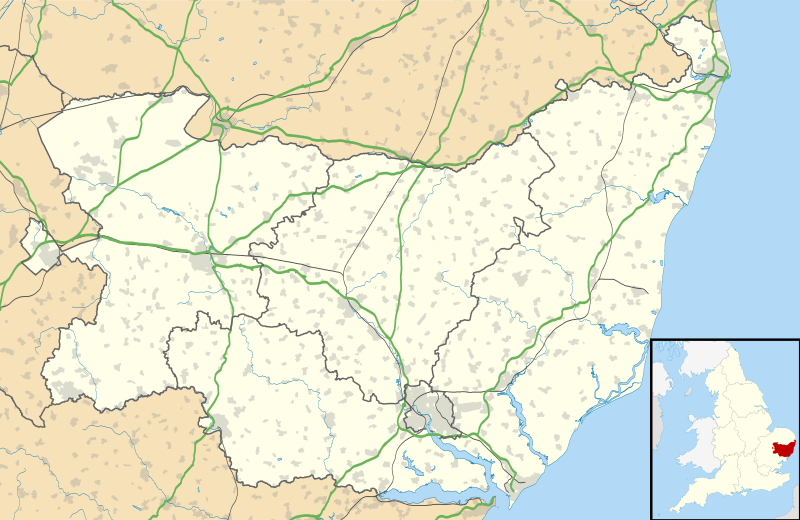Wissett
Wissett is a village and civil parish in the East Suffolk district of Suffolk, England located at 52.35N 01.46E TM3679 about 2 km (about 1.5 miles) northwest of Halesworth. Historically, it was in the Blything Hundred. It has a population of more than 200, measured at 268 in the 2011 Census.[1]
| Wissett | |
|---|---|
 Wissett, Church of St Andrew | |
 Wissett Location within Suffolk | |
| Population | 268 (2011) |
| District | |
| Shire county | |
| Region | |
| Country | England |
| Sovereign state | United Kingdom |
| Post town | Halesworth |
| Postcode district | IP19 |
| UK Parliament | |
History
Wissett manor was held by Ralph the Staller, Baron of Gael in Brittany before the Norman Conquest. Ralph was created Earl of East Anglia in 1067, but his son lost the title and the manor passed to Count Alan of Brittany and Richmond in 1075. The Domesday Book shows that in 1086 Wissett had a church at Rumburgh with two carucates of free land, twelve monks, and a chapel in the village.
The artists Vanessa Bell and Duncan Grant, and Grant's lover the writer David Garnett, lived in Wissett for the summer of 1916. Virginia Woolf (Vanessa's sister) said after visiting them: "Wissett seems to lull asleep all ambition. Don't you think they have discovered the secret of life? I thought it wonderfully harmonious."
Parish church
The eleventh-century flint parish church dedicated to Saint Andrew has a circular church tower with a floor dated to the 12th Century. This is the oldest recorded church tower floor in the United Kingdom. Built as a chapel to Rumburgh Priory, the surviving elements of the Norman church are two doors to the nave and the tower arch.
The carved wooden statue of St Andrew, the patron saint, was crafted from driftwood in 2006 by Peter Eugene Ball.
The parish is now one of fourteen which together form the Blyth Valley Team Ministry in the Diocese of Saint Edmundsbury and Ipswich.
Notable buildings
- St Andrew's Church, the parish church (see above).
- Wissett Hall, a red brick manor house.
- The Plough Inn, a village pub and free house.
- The Village Hall, a community facility dating from around 1830, and originally known as Vicarage Cottage.
- The Old Chapel, a former dissenters chapel, now a private dwelling.
- Manor Farmhouse, a 16th-century grade II* listed building.
- The Grange, a 14th century grade II* listed building.
Schools
The Wissett School Board was formed in 1878, and the village school opened the following year, 1879. It operated as a board school until 1902, when it became a local authority primary school under the provisions of the Education Act 1902. The school continued to operate until 1961, when it closed due to the small size of its roll.[2]
Today the village falls into the catchment area for Edgar Sewter Primary School, Halesworth (primary education), and Bungay High School Academy (secondary education).
The Wissett Hoards
Early in 2011 two hoards of Bronze Age axe heads and spears, together with a single rapier blade, were discovered in Wissett by two metal detectorists. The hoards were found about nine metres apart. The second hoard was excavated fully by the County Archaeological Team, and expert examination of the objects has shown them to be over three thousand years old, dating to the Middle Bronze Age.
It is considered unusual to find two hoards so close together. From the identical alloy used in both hoards, is has been postulated that they are contemporary with each other. Several of the items are of a type that have never previously been found together.
In all, fifteen objects were authenticated by the British Museum, and have been given a valuation of £4,300. They have now been purchased by the Halesworth and District Museum.
References
- "Parish population 2011". Retrieved 20 September 2015.
- "Wissett Board School". Suffolk County Council. Retrieved 10 August 2020.
- M. Kiddy, St Andrew's, Wissett: A Guide, (Wissett: 1989, revised 1997)
External links
| Wikimedia Commons has media related to Wissett. |